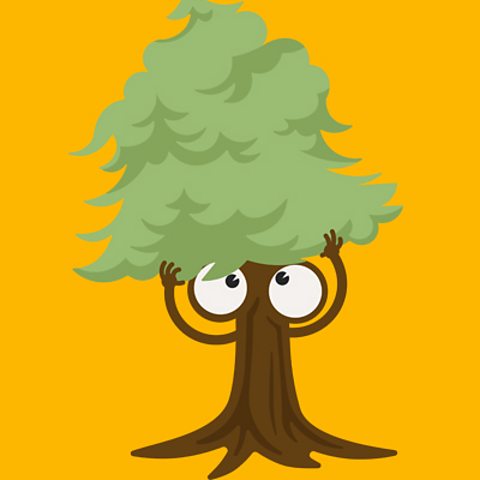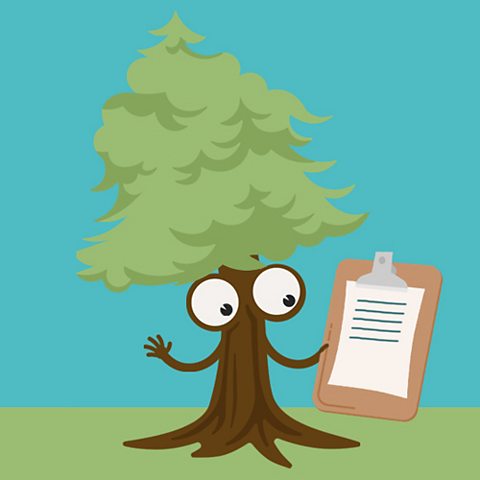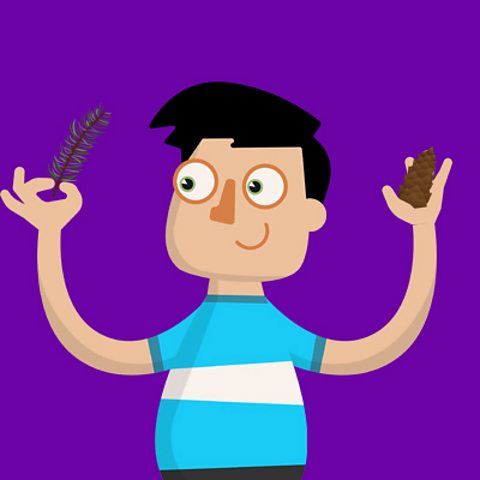
Can you be a tree seed detective?
Spreading the seeds
If you’ve ever eaten an apple or an orange, you’ll notice that they have pips in.
These pips are seeds which, when they are planted and the conditions are right, will eventually grow into new trees.
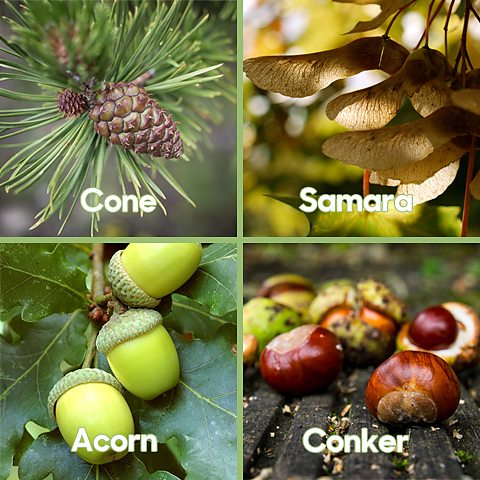
All sorts of seeds
Tree seeds come in all shapes and sizes.
Seeds can be found in the fruits that we eat, such as apples and cherries, and in berries like elderberries.
In willows and birches, seeds are found in long fluffy flower clusters called catkins. Seeds can be found in nuts as well, like the acorns we get from oaks and the conkers that fall from horse chestnuts.
Conifers like larches or pine trees have fruit called cones. Pine cones are hard and tough and made from overlapping scales. Yew trees have cones which are soft and squishy like berries.
Trees like the ash, hornbeam, maple, and sycamore have seeds with thin papery wings attached, called samaras, which help them to fly away in strong winds.
Sort the seeds
Click the picture below to find out how well you know your tree seeds.
Do you know your fruit from your nuts?
Are you super seeded? Click the picture below to see what you know about different tree seeds.
Who's in my tree?
From the top of trees to the roots way down below, woods and forests are home to a wide variety of animals.
Even the trees in our schools and gardens can be important wildlife habitats packed full of life.
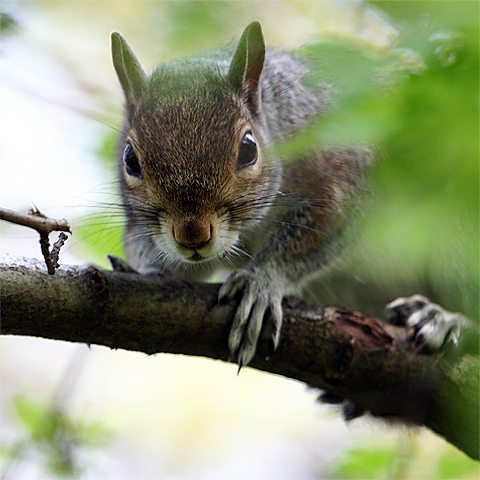
Up in the tree-tops
Lots of different types of birds will build their nests in trees.
Birds like the song thrush, house sparrows and blackbirds are common visitors to our gardens and, if you are lucky enough to have a tree near you, you may be able to spot their homes.
Birds can be encouraged to nest in trees by putting up nestboxes. Even larger birds like owls and kestrels can live happily in a nestbox, if they are made big enough.
Red and grey squirrels live in the tops of trees in nests that they build, called dreys. Squirrels mainly eat the fruits and seeds of trees, such as acorns or hazel nuts.
When there are lots of nuts in autumn, squirrels will bury food in the ground to eat through the cold winter months, when food is scarce.
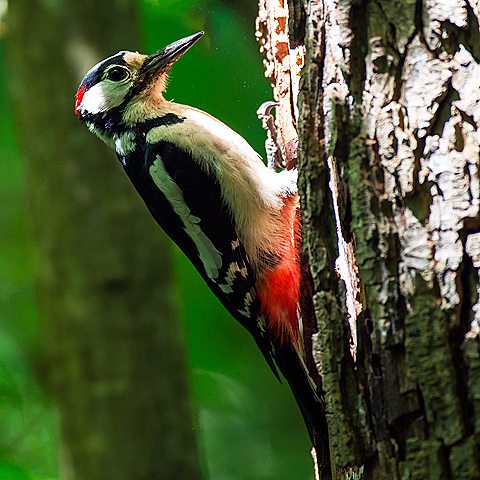
The trunk of the tree
Insects, bugs, beetles, butterflies and all sorts of mini-beasts also rely on trees.
Most trees will be home to several different types of insects and other small animals. Oaks in particular can support many hundreds of different insect species.
Insects will eat leaves, shoots, bark and even the wood itself. Sometimes this can lead to the death of the tree and many insects are classed as pests for this reason.
Help is at hand, though, as birds love to eat insects. Woodpeckers will peck through the bark of a tree to reach the insects hiding beneath it. They can also make holes in the trees with their beaks which they then build nests in.
When the woodpeckers move out these nests are often used by other birds and animals, such as squirrels.
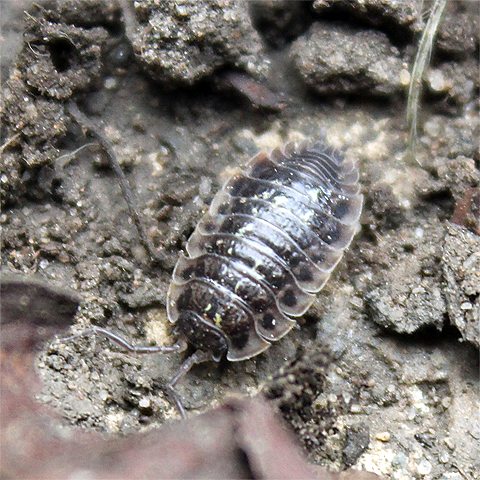
Hiding down below
Even the ground around trees is home to many different types of animal.
The leaves that fall from the trees form a thick carpet-like layer called leaf litter. Along with the dead wood from the trees, the leaf litter provides lots of food and nutrients for tiny animals.
Slugs and snails, earthworms, spiders and beetles, woodlice, millipedes and centipedes - all of these creatures and many more can be found living near the base of a tree.
And where there are insects, there will be plenty of mammals and amphibians ready to eat them: hedgehogs, badgers, wood mice, frogs and toads all enjoy a nice meal of insects!
Those animals in turn provide food for foxes, stoats, weasels and birds of prey, like buzzards, who of course can be found all the way up back where we began, in the tops of the trees.
The amazing things trees do for us

Wood you believe it?
As part of our Trees investigation, you'll be finding out about trees absorption of carbon dioxide, which helps preserve the environment and slow down climate change.
But this isn't the only fantastic thing that trees do for us.Read on and find out more.
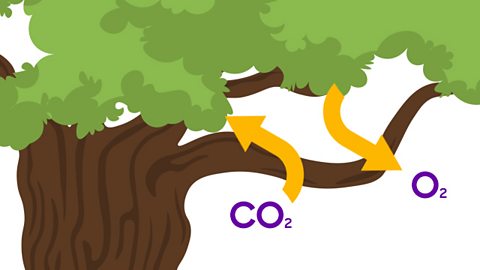
Exchanging carbon dioxide for oxygen
Storing carbon
Trees absorb a gas called carbon dioxide through their leaves. In the leaves, this gas is turned into sugar so that the tree can grow.
Carbon dioxide is the gas that humans breathe out. It is also a greenhouse gas, one which stops heat escaping the Earth's atmosphere. So, by absorbing it, trees help to reduce climate change.
Producing oxygen
Trees produce another important gas: oxygen. Oxygen is the gas in air that we need to breathe so that we can get our energy from the food that we eat. All animals breathe in oxygen, so trees are helping to keep us all alive.
So, trees take in what we breathe out and in return supply us with what we need to breathe in!
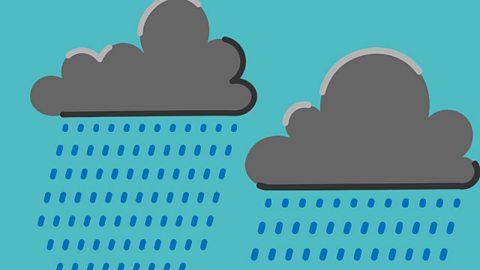
Making rain and stopping flooding
All living things need water to survive, and trees find this by absorbing water from the ground through their roots. However, just like we sweat on a hot day, trees release water to the atmosphere as a gas. The water vapour that’s released rises and condenses to form clouds, which leads to rain.
When roots take up water from the soil, they slow down the journey water takes from rain in the sky to water into our rivers. When it rains hard, this process means that the rivers' water levels don’t get as high, helping to reduce the risk of flooding.

Cleaning the air and cooling the climate
Trees help clean the air that we breathe. Air pollution from cars, lorries and factories is absorbed by the leaves and microscopic particles get stuck to them. Trees help keep our air clean and healthy.
Trees are also great to have around on a hot day. Not only can you take cover from the sun in their shade, they also help keep the temperature around them cooler! As water is released into the atmosphere, energy is taken from the air around the tree, stopping us all from getting too hot.
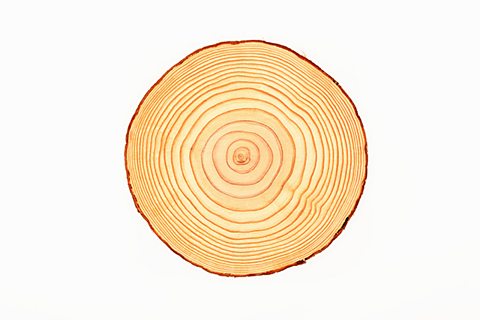
Wonderful wood
The wood from trees can be used to make various things.
Willow trees are used to make cricket bats, ash trees are used to make hockey sticks, oars and parts of guitars, the poles that hold our phone lines up are made from pine trees, while oak trees are used to make tables, barrels and even ships!
The pencils in your pencil case are likely to be made of cedar and the paper in your notebook will be made out of wood pulp too!
Did you know?!
As well as wood, trees are used to make all sorts of products we use.
Click on the labels below to find out about just a few of these!
What does a tree do all year?
Trees change a lot as the year goes by. There are two types of trees: deciduous trees lose their leaves in winter, while evergreens keep them all year round. Click the labels to read about a year in the life of a deciduous tree.
Wanted: Could you spot these tree killers?
Trees are amazing - but not invincible. Some beetles, moths or fungi can harm trees and sometimes kill them. Click on the picture below to find out more but, if you spot any of these, do not touch them!
This activity was produced in collaboration with the Forestry Commission. If you have seen clear signs of pests or diseases in your school grounds, please consider sending photos of affected trees to the Forestry Commission here to help prevent their spread.
DO NOT touch any of these. If you get skin or eye irritations, please go to your pharmacist for treatment medicine. If you think someone has had a serious allergic reaction, please see a doctor straight away.
Image copyright: The Forestry Commission/Crown Copyright and Getty.
